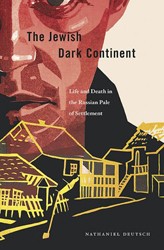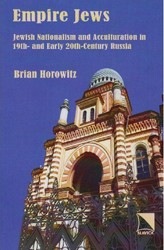The Jewish secular cultural enterprise that had begun in the decades before World War I brought the fatal crisis of Tsarist Russia. But, it was the tragic fate of that secular Jewish culture to be seized by the Soviet Communist regime that destroyed most forms of Jewish culture, along with many of the very best creators of that culture during Stalin’s reign. This book is a fundamental work on modern secular Jewish culture in Soviet Russia. Moss is a 2010 co-winner of the Sami Rohr Prize for Jewish Literature. Endnotes, illustrations, index, online bibliography.
Language, Jewish Renaissance, and Fatherhood
By Kenneth B. Moss
In 1917, as the Russian empire was convulsed by violent political and social revolution, some Russian Jews threw themselves into a very different endeavor: the creation of full-fledged modern Hebrew and Yiddish cultures with their own literature, art, music, journals, clubs, publishing houses, and schools. My book, Jewish Renaissance in the Russian Revolution, is the first comprehensive history of this exciting, tragic endeavor. Based on years of research in Hebrew, Yiddish, and Russian, in a dozen archives on three continents, the book portrays the lives and works of talented Jewish writers, artists, and intellectuals amidst gathering political storms.
These would-be creators of a new culture aspired to re-found Jewish life not so much by renovating traditional Judaism in some way, but on the basis of a secular, European literature and art, and above all on the basis of living in a separate Jewish language, be it Hebrew or Yiddish.
This vision of a new Jewish culture was rooted in profound changes in Jewish life that had been underway since the 19th century. By 1917, many Jews were quite secular, or at least irreligious, and alienated from traditional Judaism. Many were also at home in the European cultures around them — Russian, Polish, German. Against this backdrop arose the idea of a new Jewish culture that would emulate these other cultures yet also stand as their equal. It couldn’t be narrow or confining either in religious or in national terms. It had to be as broad and as open as Russian culture or as French culture. These conditions led to the new Jewish culture’s most paradoxical rule: that the new culture shouldn’t be defined or limited by any particular Jewish content (though it could certainly have Jewish content too), but did have to be defined by the choice of a single, separate Jewish language (either Hebrew or Yiddish).
Looking back, I don’t think I fully understood why the subjects of my research/history/book embraced this view so intensely until I discovered a strange biographical coincidence. When I first began the research for this project, in 1998, I was a 23-year-old graduate student. When I was finally ready to take a sabbatical and rewrite the manuscript for publication in 2006, I was 32 and the father of two young children. A great many of the figures I was studying had reached that exact point in their lives — marriage and children — around 1917.
I thus had a new perspective on something that scholars have long recognized: that it was in the 1917 – 1921 period that both Hebrew and Yiddish children’s literature began to develop and blossom. But I also understood something deeper: the source of their seemingly paradoxical ideas about Jewish culture in light of their situation as cultural rebels turned young fathers. These were people who had broken with traditional Jewish culture because they had discovered the wonders of Western culture — European art, music, poetry. For various reasons, though, they had chosen not to abandon Jewish life altogether in search of these things. They had remained faithful to some ideal of Jewish continuity and Jewish renewal, which they framed as national renewal. But they couldn’t imagine imposing on their children the kind of narrow Jewish education they had grown up with. On the other hand, how were they going to give their children a substantial, worthwhile Jewish culture and prevent them from simply assimilating to the larger non-Jewish cultures around them? The answer they came up with was language: raise the children in Hebrew or Yiddish, educate them in Hebrew or Yiddish, and give them everything, Jewish texts and non-Jewish culture too, in those languages. Ideally, their children would never face the terrible prospect of having to choose between being a free, fulfilled modern person or a committed member of the Jewish people.
I am tremendously excited that the Jewish Book Council and the distinguished judges of the Sami Rohr Prize have chosen Jewish Renaissance in the Russian Revolution as a 2010 co-winner of the Sami Rohr Prize. I’m gratified that other people who have thought long and hard about Jewish life should see in this topic some importance, and excited to think that with the imprimatur of the JBC, the book might now reach more readers in the Jewish community.
My book about this Hebrew-Yiddish dream, its tragedies, and its incredible Hebrew realization was written in English, for Americans and American Jews first and foremost, and it is for Jewish culture in English that the Rohr Prize is given. The award ceremony for the prize will be conducted in Jerusalem, and as we celebrate American Jewish culture in English, we will also have the chance to immerse ourselves in the sights and sounds of a country where Jews can carry Jewish culture into the future merely by speaking to their children. American Jews face a harder task, I think. We must seek to create and maintain Jewish culture consciously, against the flow of everyday life and against the current of the wonderful opportunities that America offers. Naturally, we will continue to do so above all in English, using the riches of the English language and its literary traditions for Jewish ends. But I believe that if we create our American Jewish culture without seeking dialogue with the Jewish worlds created and still being created in Yiddish and Hebrew, we will be the poorer for it. In hindsight, Jewish Renaissance in the Russian Revolution was inspired by this conviction. That this idea could find a hearing among readers and judges who have devoted themselves to cultivating American Jewish culture in the broadest and best sense inspires tremendous gratitude on my part, and no little optimism.





